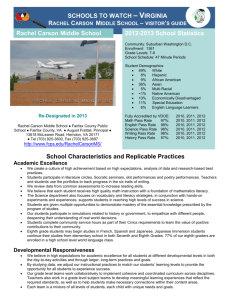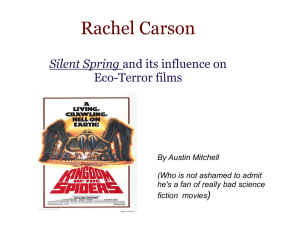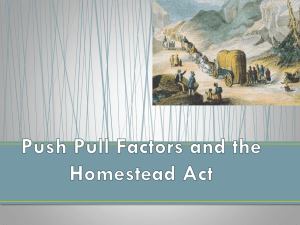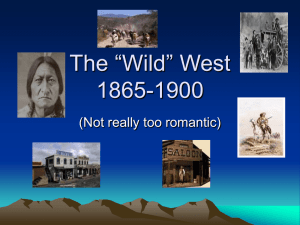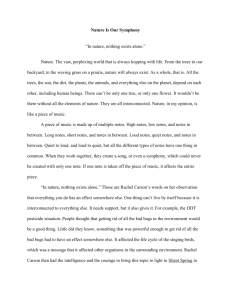Rachel Carson Homestead Association
advertisement
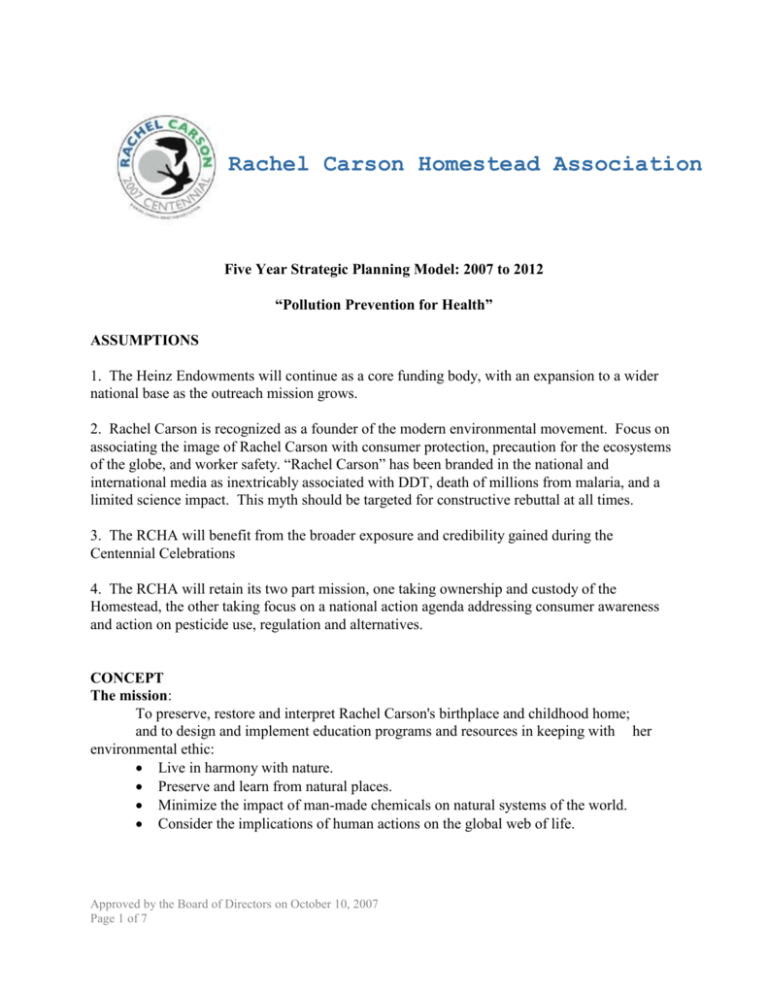
Rachel Carson Homestead Association Mmm Five Year Strategic Planning Model: 2007 to 2012 “Pollution Prevention for Health” ASSUMPTIONS 1. The Heinz Endowments will continue as a core funding body, with an expansion to a wider national base as the outreach mission grows. 2. Rachel Carson is recognized as a founder of the modern environmental movement. Focus on associating the image of Rachel Carson with consumer protection, precaution for the ecosystems of the globe, and worker safety. “Rachel Carson” has been branded in the national and international media as inextricably associated with DDT, death of millions from malaria, and a limited science impact. This myth should be targeted for constructive rebuttal at all times. 3. The RCHA will benefit from the broader exposure and credibility gained during the Centennial Celebrations 4. The RCHA will retain its two part mission, one taking ownership and custody of the Homestead, the other taking focus on a national action agenda addressing consumer awareness and action on pesticide use, regulation and alternatives. CONCEPT The mission: To preserve, restore and interpret Rachel Carson's birthplace and childhood home; and to design and implement education programs and resources in keeping with her environmental ethic: Live in harmony with nature. Preserve and learn from natural places. Minimize the impact of man-made chemicals on natural systems of the world. Consider the implications of human actions on the global web of life. Approved by the Board of Directors on October 10, 2007 Page 1 of 7 The RCHA will maintain its two pronged mission but not with equal emphasis: The Homestead preservation and presentation is limited by physical condition, space, and location. Its promotion and maintenance will occur within the parameters of the Rivers of Steel Heritage Area, and programs presented through the Homestead will focus on the inspirational value of Rachel Carson as an icon of the environment movement. The environmental education and outreach functions will expand from a local focus to a national focus with specific attention around organic and sustainable food chain management, including integrated pest management principles, and building consumer awareness around toxic and biologically harmful synthetic compounds and practices. The proactive advocacy function will increase over time, beginning with a focus on regulation of chemicals, such as atrazine, which are banned in Europe under the European Commission precautionary principle. Focus: The RCHA will address the use of commercial agriculture pesticides and herbicides as a niche focus for its action agenda. The promotion of organic and sustainable agricultural products as a counterpoint to heavily chemically dependent cultivation will be a corollary to this action. The economic effects resulting from pesticide and GMO food cultivation in the US when the European markets refuse to accept them must also be considered. Outreach around organic and sustainable foods, home and garden care without pesticides and herbicides will continue from the Homestead, and reach out to a national audience. Issues we need to tackle: genetically modified foods/seeds The nature of the “harm” from fertilizers, herbcides and pesticides…endocrine disruptors Toxicology vs precaution as a standard Unintended consequences of corn for biofuel Approach: Identify compelling issues and identify constructive alternatives in terms of consumer choices, government policies, or industry research for safer options. Craft positive, empowering messages, rather than overwhelming people with negative data that causes paralysis of response. 2012 Program Goals: The RCHA Program will proceed along two tracks; one to address the national education awareness and action campaign to control the harm from synthetic chemicals, and one to focus on the Homestead. Each of the objectives will have annual strategies and actions for operations every year for five years. (Matrix in progress) Approved by the Board of Directors on October 10, 2007 Page 2 of 7 Goal I: To achieve national recognition of the unintended consequences for human health from exposure to mixtures of chemicals produced in the food chain, and the availability of healthier alternatives. Begin with advocating for a ban on use in the United States of chemicals, such as atrazine, which are disallowed in Europe under the precautionary principle, based on biological effects and economic consequences. Objectives: 1. Expand national consumer awareness about harmful chemicals in the environment. Consumers have an important role in helping to solve the problem of chemical pollution. People can make better choices, and reduce market demand for harmful products. Informed consumers can demand accountability from manufacturers and can demand safer alternatives to products or processes that cause harm. 2. Demand Safer Alternatives from industry and academic researchers. The structure follows the function…we need to identify and promote safer alternatives to harmful chemicals, and see to it that the standards for release and production of new ones do not allow more of the same. This will require the involvement of green chemistry academicians, as well as sympathetic and supportive industry people. The objective is to identify commercially viable, effective and earth friendly products. 3. Demand accountability of regulators in protecting consumers and workers from harmful chemicals. We will seek to change the U.S. regulatory standard for introduction and use of synthetic chemicals based on the precaution principle, as used in the European Union. Goal II: To preserve and present the Rachel Carson Homestead as a source of inspiration based on the life of Rachel Carson and her works. Objectives: 1. Maintain and preserve the Homestead infrastructure in a manner that displays the time of the Carson’s inhabitance in the early 1900’s 2. Present the Carson Homestead as an example of sound energy conservation, land and garden maintenance and presentation, and suburban habitat diversity. 3. Present education programs and events consistent with the physical limitations of the structure to preserve the legacy of Rachel Carson. ORGANIZATION Board of Directors The Board of Directors must expand to represent the national scope of the mission. The Board must be organized to maintain the mission functionality, and have the influence and credibility to generate the required funds for success. Approved by the Board of Directors on October 10, 2007 Page 3 of 7 RCHA should seek guidance and assistance from the Duquesne University Nonprofit Leadership Institute, Boards by Design program. Board Committees: Executive Committee- meet monthly to review financial decisions, address strategic direction, and maintain focus on mission priorities within scope of funding. Development and Finance Committee: fundraising, membership Expand sustaining funders to 30 to 50 sources; Increase membership to a national base Homestead Committee: maintenance and operations of the Homestead, museum functions, volunteers and docent quality, and local education outreach programs Marketing Committee: make contacts and connections, review and recommend positions to the Board through the Executive Committee; oversee the national marketing and action campaign Institutional Capacity: 1. Rachel Carson Homestead as a National Historic Landmark – passport portal for National Park Service; local economic development tie to the Allegheny Valley; Rachel Carson early life and education; impact and continued relevance of her work; living example of chemical free home and garden management 2. National Consumer awareness and advocacy – The credible development of information, materials and actions will rely on the input and guidance of a national Science Advisory Council to define issues, review and develop information for the public, and provide expert assistance in crafting and delivering the message. Focus on positive alternatives and empowering consumer choices. 3. Revenue generation For profit subsidiary as a venue (outdoor weddings etc…) Conferences and workshops (Act 48) Retail operations-Web based Gift shop partnerships (eg books through Amazon) Partnerships Center for Environmental Oncology University of Pittsburgh Graduate School of Public Health River Quest Women’s Environment and Health Network Beyond Pesticides Approved by the Board of Directors on October 10, 2007 Page 4 of 7 National Advisory Board E.O.Wilson Paul Anastas, Yale University Rich Liroff, Investors Environmental Health Network Devra Davis – Cancer Institute Center for Environmental Oncology, University of Pittsburgh Dan Volz – Pitt Graduate School of Public Health Linda Lear Tyrone Hayes Terry Collins - Carnegie Mellon University David Orr - Oberlin Randolph A. Miller- Vanderbilt University School of Medicine Eric Beckman Mascaro Sustainability Institute, University of Pittsburgh Roger Christie Rita Colwell – University of Maryland, Biomolecular Sciences Mary Ann Baroff, VP Clinical Health, Highmark Pete Myers – Environmental Health Sciences David Seybert, Duquesne University To accomplish the goals of the RCHA for the nest five years, the following charts illustrate a revised functional organization and structure of the organization. Approved by the Board of Directors on October 10, 2007 Page 5 of 7 Rachel Carson Homestead Association Functional Organization: 2007 – 2012 Board of Directors Advisory Board Executive Director Executive Committee Development &Finance Homestead Operations: Homestead Committee Outreach Operations Marketing Committee Museum Consumer awareness and education Gift Shop Industry/Academic On Site and On Line Education Program on site and off site Note: Regulatory advocacy function not currently in place. Approved by the Board of Directors on October 10, 2007 Page 6 of 7 *Regulatory advocacy Rachel Carson Homestead Association Strategic Organization 2007-2012 Executive Director Administrative Assistant Education Director Museum Docents Volunteer College Interns Museum Gift Shop On-Site & Off Site Program Marketing Director Web consultant National Consumer Education Web information Newsletter Advertisements Collaborative promotion Note: Functions in italics are not currently in place. Approved by the Board of Directors on October 10, 2007 Page 7 of 7 Science Director Advocacy Counsel Industry Participants Academic Participants Research Challenge Science expertise Content development

